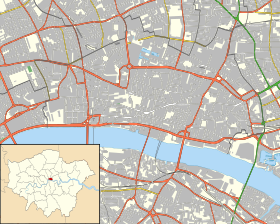
Back جدار لندن Arabic جدار لندن ARZ লন্ডন ওয়াল Bengali/Bangla London Wall Danish London Wall German Muro de Londono Esperanto Muralla de Londres Spanish Londoni linnamüür Estonian Lontoon muuri Finnish Mur de Londres French
 London Roman Wall – surviving section by Tower Hill gardens cross-section | |
| Location | Central London |
|---|---|
| Region | Greater London |
| Coordinates | 51°31′N 0°05′W / 51.51°N 0.08°W |
| Type | Fortification |
| Length | 2.5 miles (4.0 km)[1] |
| Area | 0.514 m² |
| History | |
| Material | Kentish ragstone (Roman sections) and brick (later additions) |
| Founded | c. AD 200 |
| Periods | Roman to late 18th century |
| Site notes | |
| Condition | Fragmentary remains |
| Public access | Partially |

The London Wall is a defensive wall first built by the Romans around the strategically important port town of Londinium in c. AD 200,[2] as well as the name of a modern street in the City of London, England.
Roman London was, from around 120–150, protected by a large fort, with a large garrison, that stood to its north-western side. The fort, now referred to as the Cripplegate Fort, was later incorporated into a comprehensive city-wide defence, with its strengthened northern and western sides becoming part of the Wall which was built around 200. The incorporation of the fort's walls gave the walled area its distinctive shape in the north-west part of the city.
The end of Roman rule in Britain, around 410, led to the wall falling into disrepair. It was restored in the late Anglo-Saxon period, a process generally thought to have begun under Alfred the Great after 886. Repairs and enhancements continued throughout the medieval period. The wall largely defined the boundaries of the City of London until the later Middle Ages, when population rises and the development of towns around the city blurred the perimeter.[2]
From the 18th century onward, the expansion of the City of London saw large parts of the wall demolished, including its city gates, to improve traffic flow. Since the Second World War, conservation efforts have helped to preserve surviving sections of the city wall as scheduled monuments.
The long presence of the walls has had a profound and continuing effect on the character of the City of London, and surrounding areas.[3] The walls constrained the growth of the city, and the location of the limited number of gates and the route of the roads through them shaped development within the walls, and more fundamentally, beyond them. With few exceptions, the modern roads heading into the former walled area are the same as those which passed through the former medieval gates.
- ^ "History of London Wall". English Heritage. Retrieved 3 March 2021.
- ^ a b Mann, Emily (2006). "In Defence of the City: The Gates of London and Temple Bar in the Seventeenth Century". Architectural History. 49: 75–99. doi:10.1017/S0066622X00002719. ISSN 0066-622X. S2CID 194811909.
- ^ Citadel of the Saxons, the Rise of Early London. Rory Naismith, p. 31
